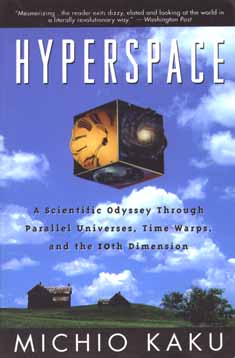|
|
 The appeal of science fiction comes from the fact that it explores new territory, new concepts that challenge the mind. The great thing about sci-fi however, is that often there is some scientific basis behind the story. Carl Sagan, one of the greatest sci-fi writers of all time often consulted his physicist friends for ideas. After a really satisfying novel or movie, you may even be compelled to learn more about a subject, or see if there is any truth to it. I'm not saying that shows like Star Trek spawn generations of eager theoretical physicists, but for those of you who are curious about what is going on at the forefront of theoretical physics, I found a book that might interest you. The appeal of science fiction comes from the fact that it explores new territory, new concepts that challenge the mind. The great thing about sci-fi however, is that often there is some scientific basis behind the story. Carl Sagan, one of the greatest sci-fi writers of all time often consulted his physicist friends for ideas. After a really satisfying novel or movie, you may even be compelled to learn more about a subject, or see if there is any truth to it. I'm not saying that shows like Star Trek spawn generations of eager theoretical physicists, but for those of you who are curious about what is going on at the forefront of theoretical physics, I found a book that might interest you.I stumbled upon this book by accident, while shuffling through the a local Borders trying to find a way to blow my gift certificates. The cover immediately caught my eye. At first, I thought it was a misplaced novel, or a feeble attempt to make the meager physics section look bigger, but the book's introduction told me otherwise. Michio Kaku is a theoretical physics professor, who graduated from Harvard and received his Ph.D. from University of California, Berkeley. He also has written several books, and hosts a weekly science program on the radio. Hyperspace covers many of the current theories about the start of the universe, where it may end, and what we are learning about it in the meantime to come up with the grand unified theory for all of physics. If you are looking for someone to explain the basics of superstring theory to you in layman's terms, this is a great place to start. The primary idea running through the entire book is the idea that the four fundamental forces can be explained with one grand unified theory if the universe is thought of as ten dimensional. Before you dismiss this idea as merely science fiction, perhaps you should hear it from Professor Kaku. He eloquently describes the history and evolution of several competing theories, stopping occasionally to offer an anecdote. I especially like his use of analogies and metaphors, some of which are carried throughout the book, bringing unity to the breadth of information provided. While I consider Hyperspace a great read, and would recommend it to any physics student who is curious about black holes, time travel, and other fringe concepts, there were some aspects of the book that seemed relatively weak. Some points were repetitive, and in the beginning, I thought his thesis was stated a few too many times. Professor Kaku is decidedly biassed towards superstring theory, but he at least offers explanations of the competing theories. Perhaps in an effort to engage a variety of people and thinking styles, Kaku includes many literary quotes. Some of them are entertaining introductions to a passage, but others I found vague. Professor Kaku makes extensive use of footnotes, so if you want the full story, be prepared to flip occasionally to the end of the book. I found this distracting, but perhaps it is necessary. Chapters were divided into a logical progression that I liked very much. Digressions were very helpful in adding character to the narrative, my favorite being the discussion of futurology, and the four classifications of a technologically advanced society. I'll admit, some of the information flew right over my head, so to speak, but at least I can say that I heard of something if it comes up in a college lecture. While written for the average Joe, there are plenty of concepts and footnote equations for the hard-core physicist to chew on. If you think the beginning is slow, keep going because it gets better. If you loved the beginning, hang on for a ride through exciting theories that until now you may have only seen on television. Don't worry, Kaku makes plenty of references to other books and authors, should you choose to go back to the bookstore. ***Note that although there have been some recent developments in superstring theory since the publication of this book, I still recommend it to anyone who craves an introduction to string theory.*** |
